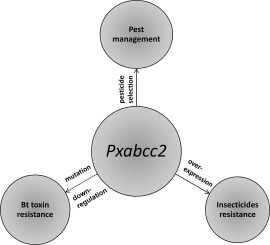当前位置:
X-MOL 学术
›
Pestic. Biochem. Phys.
›
论文详情
Our official English website, www.x-mol.net, welcomes your feedback! (Note: you will need to create a separate account there.)
ABCC2 participates in the resistance of Plutella xylostella to chemical insecticides
Pesticide Biochemistry and Physiology ( IF 4.7 ) Pub Date : 2020-01-01 , DOI: 10.1016/j.pestbp.2019.08.010 Jie Xu 1 , Zanyong Wang 2 , Yafei Wang 1 , Haihao Ma 2 , Hang Zhu 2 , Jia Liu 2 , Yong Zhou 2 , Xile Deng 2 , Xiaomao Zhou 3
Pesticide Biochemistry and Physiology ( IF 4.7 ) Pub Date : 2020-01-01 , DOI: 10.1016/j.pestbp.2019.08.010 Jie Xu 1 , Zanyong Wang 2 , Yafei Wang 1 , Haihao Ma 2 , Hang Zhu 2 , Jia Liu 2 , Yong Zhou 2 , Xile Deng 2 , Xiaomao Zhou 3
Affiliation

|
The ABCC2 protein of Plutella xylostella is an important target of Cry1A toxins from Bacillus thuringiensis (Bt), but whether this protein is involved in the resistance of P. xylostella to other insecticides remains unclear. In this study, the abcc2 gene of P. xylostella was cloned and the expression levels of Pxabcc2 in susceptible and resistant strains were investigated. ABCC2 was found to be expressed 3.2-6.7-fold higher in the resistant strain than in the susceptible strain; in the surviving P. xylostella, ABCC2 levels were significantly higher when treated with indoxacarb, avermectin, and beta-cypermethrin. We constructed a stable ABCC2-expressing HEK-293 cell line to reveal the contribution of ABCC2 to insecticide resistance. The avermectin and chlorfenapyr sensitivities of the stably-transfected cell line were significantly lower than those of the control cells. The intracellular avermectin concentration was significantly lower in the stably-transfected cell line than in the control cells after four hours of exposure. This study shows that up-regulated ABCC2 expression is related to insecticide resistance in P. xylostella. Moreover, we used RNA interference technology to reduce ABCC2 levels in P. xylostella. Down-regulating ABCC2 expression did not significantly affect avermectin or chlorfenapyr resistance in P. xylostella. We speculate that increased ABCC2 expression can enhance metabolic resistance in P. xylostella. This study also provides new insights into cross-resistance between B. thuringiensis toxins and chemical insecticides.
中文翻译:

ABCC2参与小菜蛾对化学杀虫剂的抗性
小菜蛾ABCC2蛋白是苏云金芽孢杆菌(Bt)Cry1A毒素的重要靶点,但该蛋白是否参与小菜蛾对其他杀虫剂的抗性尚不清楚。本研究克隆了小菜蛾的abcc2基因,研究了Pxabcc2在敏感菌株和抗性菌株中的表达水平。发现 ABCC2 在抗性菌株中的表达比在易感菌株中高 3.2-6.7 倍;在幸存的小菜蛾中,当用茚虫威、阿维菌素和 β-氯氰菊酯处理时,ABCC2 水平显着升高。我们构建了一个稳定的表达 ABCC2 的 HEK-293 细胞系,以揭示 ABCC2 对杀虫剂抗性的贡献。稳定转染细胞系的阿维菌素和氯芬那定的敏感性显着低于对照细胞。暴露四小时后,稳定转染的细胞系中的细胞内阿凡曼菌素浓度显着低于对照细胞。该研究表明上调的 ABCC2 表达与小菜蛾的杀虫剂抗性有关。此外,我们使用 RNA 干扰技术来降低小菜蛾中的 ABCC2 水平。下调 ABCC2 表达不会显着影响小菜蛾中的阿维菌素或氯芬那定抗性。我们推测增加的 ABCC2 表达可以增强小菜蛾的代谢抗性。这项研究还为了解苏云金芽孢杆菌毒素和化学杀虫剂之间的交叉抗性提供了新的见解。暴露四小时后,稳定转染的细胞系中的细胞内阿凡曼菌素浓度显着低于对照细胞。该研究表明上调的 ABCC2 表达与小菜蛾的杀虫剂抗性有关。此外,我们使用 RNA 干扰技术来降低小菜蛾中的 ABCC2 水平。下调 ABCC2 表达不会显着影响小菜蛾中的阿维菌素或氯芬那定抗性。我们推测增加的 ABCC2 表达可以增强小菜蛾的代谢抗性。这项研究还为了解苏云金芽孢杆菌毒素和化学杀虫剂之间的交叉抗性提供了新的见解。暴露四小时后,稳定转染的细胞系中的细胞内阿凡曼菌素浓度显着低于对照细胞。该研究表明上调的 ABCC2 表达与小菜蛾的杀虫剂抗性有关。此外,我们使用 RNA 干扰技术来降低小菜蛾中的 ABCC2 水平。下调 ABCC2 表达不会显着影响小菜蛾中的阿维菌素或氯芬那定抗性。我们推测增加的 ABCC2 表达可以增强小菜蛾的代谢抗性。这项研究还为了解苏云金芽孢杆菌毒素和化学杀虫剂之间的交叉抗性提供了新的见解。该研究表明上调的 ABCC2 表达与小菜蛾的杀虫剂抗性有关。此外,我们使用 RNA 干扰技术来降低小菜蛾中的 ABCC2 水平。下调 ABCC2 表达不会显着影响小菜蛾中的阿维菌素或氯芬那定抗性。我们推测增加的 ABCC2 表达可以增强小菜蛾的代谢抗性。这项研究还为了解苏云金芽孢杆菌毒素和化学杀虫剂之间的交叉抗性提供了新的见解。该研究表明上调的 ABCC2 表达与小菜蛾的杀虫剂抗性有关。此外,我们使用 RNA 干扰技术来降低小菜蛾中的 ABCC2 水平。下调 ABCC2 表达不会显着影响小菜蛾中的阿维菌素或氯芬那定抗性。我们推测增加的 ABCC2 表达可以增强小菜蛾的代谢抗性。这项研究还为了解苏云金芽孢杆菌毒素和化学杀虫剂之间的交叉抗性提供了新的见解。我们推测增加的 ABCC2 表达可以增强小菜蛾的代谢抗性。这项研究还为了解苏云金芽孢杆菌毒素和化学杀虫剂之间的交叉抗性提供了新的见解。我们推测增加的 ABCC2 表达可以增强小菜蛾的代谢抗性。这项研究还为了解苏云金芽孢杆菌毒素和化学杀虫剂之间的交叉抗性提供了新的见解。
更新日期:2020-01-01
中文翻译:

ABCC2参与小菜蛾对化学杀虫剂的抗性
小菜蛾ABCC2蛋白是苏云金芽孢杆菌(Bt)Cry1A毒素的重要靶点,但该蛋白是否参与小菜蛾对其他杀虫剂的抗性尚不清楚。本研究克隆了小菜蛾的abcc2基因,研究了Pxabcc2在敏感菌株和抗性菌株中的表达水平。发现 ABCC2 在抗性菌株中的表达比在易感菌株中高 3.2-6.7 倍;在幸存的小菜蛾中,当用茚虫威、阿维菌素和 β-氯氰菊酯处理时,ABCC2 水平显着升高。我们构建了一个稳定的表达 ABCC2 的 HEK-293 细胞系,以揭示 ABCC2 对杀虫剂抗性的贡献。稳定转染细胞系的阿维菌素和氯芬那定的敏感性显着低于对照细胞。暴露四小时后,稳定转染的细胞系中的细胞内阿凡曼菌素浓度显着低于对照细胞。该研究表明上调的 ABCC2 表达与小菜蛾的杀虫剂抗性有关。此外,我们使用 RNA 干扰技术来降低小菜蛾中的 ABCC2 水平。下调 ABCC2 表达不会显着影响小菜蛾中的阿维菌素或氯芬那定抗性。我们推测增加的 ABCC2 表达可以增强小菜蛾的代谢抗性。这项研究还为了解苏云金芽孢杆菌毒素和化学杀虫剂之间的交叉抗性提供了新的见解。暴露四小时后,稳定转染的细胞系中的细胞内阿凡曼菌素浓度显着低于对照细胞。该研究表明上调的 ABCC2 表达与小菜蛾的杀虫剂抗性有关。此外,我们使用 RNA 干扰技术来降低小菜蛾中的 ABCC2 水平。下调 ABCC2 表达不会显着影响小菜蛾中的阿维菌素或氯芬那定抗性。我们推测增加的 ABCC2 表达可以增强小菜蛾的代谢抗性。这项研究还为了解苏云金芽孢杆菌毒素和化学杀虫剂之间的交叉抗性提供了新的见解。暴露四小时后,稳定转染的细胞系中的细胞内阿凡曼菌素浓度显着低于对照细胞。该研究表明上调的 ABCC2 表达与小菜蛾的杀虫剂抗性有关。此外,我们使用 RNA 干扰技术来降低小菜蛾中的 ABCC2 水平。下调 ABCC2 表达不会显着影响小菜蛾中的阿维菌素或氯芬那定抗性。我们推测增加的 ABCC2 表达可以增强小菜蛾的代谢抗性。这项研究还为了解苏云金芽孢杆菌毒素和化学杀虫剂之间的交叉抗性提供了新的见解。该研究表明上调的 ABCC2 表达与小菜蛾的杀虫剂抗性有关。此外,我们使用 RNA 干扰技术来降低小菜蛾中的 ABCC2 水平。下调 ABCC2 表达不会显着影响小菜蛾中的阿维菌素或氯芬那定抗性。我们推测增加的 ABCC2 表达可以增强小菜蛾的代谢抗性。这项研究还为了解苏云金芽孢杆菌毒素和化学杀虫剂之间的交叉抗性提供了新的见解。该研究表明上调的 ABCC2 表达与小菜蛾的杀虫剂抗性有关。此外,我们使用 RNA 干扰技术来降低小菜蛾中的 ABCC2 水平。下调 ABCC2 表达不会显着影响小菜蛾中的阿维菌素或氯芬那定抗性。我们推测增加的 ABCC2 表达可以增强小菜蛾的代谢抗性。这项研究还为了解苏云金芽孢杆菌毒素和化学杀虫剂之间的交叉抗性提供了新的见解。我们推测增加的 ABCC2 表达可以增强小菜蛾的代谢抗性。这项研究还为了解苏云金芽孢杆菌毒素和化学杀虫剂之间的交叉抗性提供了新的见解。我们推测增加的 ABCC2 表达可以增强小菜蛾的代谢抗性。这项研究还为了解苏云金芽孢杆菌毒素和化学杀虫剂之间的交叉抗性提供了新的见解。



























 京公网安备 11010802027423号
京公网安备 11010802027423号